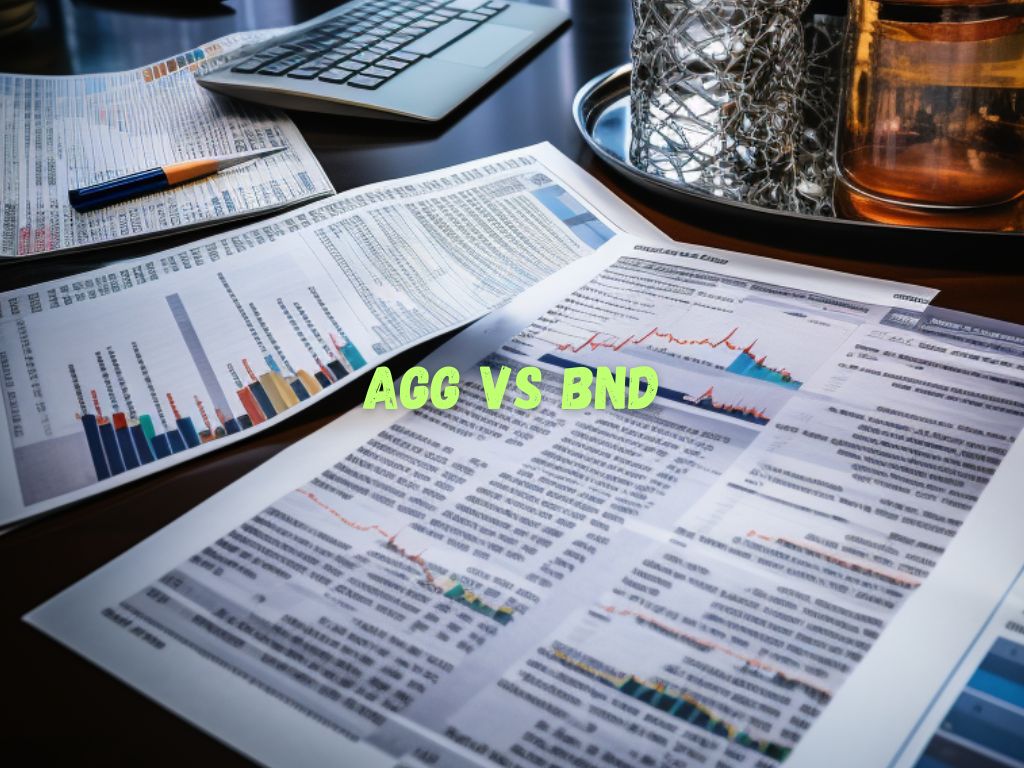Bond ETFs serve as crucial components of a diversified investment portfolio, offering exposure to fixed income securities.
Two popular bond ETFs, AGG (iShares Core U.S. Aggregate Bond ETF) and BND (Vanguard Total Bond Market ETF), are frequently considered by investors.
In this article we will try to decode AGG vs BND to help you take an informed investment decision.
While both AGG and BND have their merits, understanding their nuances and key features is essential for making an informed investment decision.
Understanding AGG and BND
Bond ETFs are funds that comprise a basket of bonds that trade on public markets.
AGG, managed by BlackRock, tracks the performance of the Bloomberg Barclays U.S. Aggregate Bond Index, commonly known as the Aggregate.
BND, managed by Vanguard, aims to replicate the performance of the Bloomberg Barclays U.S. Aggregate Float Adjusted Index.
The primary objective of AGG and BND is to provide investors with broad exposure to the U.S. fixed income market.
They represent a diverse mix of bonds, including Treasury bonds, corporate bonds, mortgage-backed securities, and government agency bonds.

AGG vs BND: A Quick Comparison
Market Capitalization:
AGG has a larger market capitalization than BND. As of September 2021, AGG’s market capitalization was approximately $87.5 billion, while BND’s market capitalization was approximately $68.3 billion.
Asset Allocation:
AGG and BND have slightly different asset allocations, which can impact their performance and risk characteristics:
AGG: As of September 2023, AGG had the following asset allocation:
- U.S. Treasury Bonds: 38%
- Mortgage-Backed Securities: 28%
- U.S. Corporate Bonds: 18%
- U.S. Agency Bonds: 10%
- Other: 6%
BND: As of September 2023, BND had the following asset allocation:
- U.S. Treasury Bonds: 31%
- Mortgage-Backed Securities: 33%
- U.S. Corporate Bonds: 26%
- U.S. Agency Bonds: 7%
- Other: 3%
Credit Quality:
Both AGG and BND have exposure to a range of credit qualities, including investment-grade and high-yield bonds. However, there are slight differences in their allocations:
AGG: AGG has a higher allocation to investment-grade bonds, which may result in lower credit risk and lower yield. As of September 2023, AGG had the following credit quality breakdown:
- AAA: 36%
- AA: 28%
- A: 24%
- BBB: 10%
- Below BBB: 2%
BND: BND also has exposure to investment-grade bonds, but its allocation to lower-quality bonds is slightly higher. As of September 2023, BND had the following credit quality breakdown:
- AAA: 25%
- AA: 32%
- A: 22%
- BBB: 19%
- Below BBB: 2%
Duration:
Duration measures the sensitivity of bond prices to changes in interest rates. AGG and BND have slightly different durations:
- AGG: AGG has a duration of approximately 6.60 years, indicating that its price would be expected to change by approximately 6.60% for every 1% change in interest rates.
- BND: BND has a duration of approximately 5.83 years, meaning its price would be expected to change by approximately 5.83% for every 1% change in interest rates.
Portfolio Turnover:
Portfolio turnover measures how frequently a fund buys and sells its holdings. AGG and BND have different portfolio turnover rates:
- AGG: AGG has a lower portfolio turnover rate than BND, which indicates that it buys and sells securities less frequently. AGG has an annual portfolio turnover rate of approximately 6%.
- BND: BND has a notably higher portfolio turnover rate than AGG. Its annual portfolio turnover rate is approximately 24%.
Investors should consider these composition and asset allocation factors when assessing the risk and potential returns of AGG and BND.
It is important to note that allocations can change over time as fund managers make adjustments to their portfolios.

AGG vs BND: A Comprehensive Comparison
Performance Comparison
Comparing historical returns is a crucial factor when assessing the performance of AGG and BND. Over the past decade, AGG has slightly outperformed BND, delivering average annual returns of 4.12% versus 3.90% for BND.
Yields are another important metric to consider when comparing AGG and BND’s performance.
As of September 2021, AGG had a yield of 1.14%, while BND had a yield of 1.51%. AGG tends to generate lower yields due to its focus on high-quality, low-risk bonds. BND may provide slightly higher yields due to its inclusion of corporate bonds.
Investors should also consider volatility when assessing the performance of AGG and BND. AGG has exhibited lower volatility compared to BND, providing more stable returns for risk-averse investors.
AGG has a 3-year standard deviation of 2.71%, compared to BND’s 3-year standard deviation of 2.87%.
Both AGG and BND have proven to be resilient during market downturns. During the COVID-19 pandemic in 2020, AGG and BND performed well, with AGG generating a return of 7.51% and BND generating a return of 7.27%.
Fund flows can also provide insights into the performance of AGG and BND. As of September 2021, AGG had a total net inflow of $9.17 billion, while BND had a total net inflow of $5.23 billion.
While fund flows do not necessarily indicate future performance, they can reflect investor sentiment towards each ETF.
It is important to note that past performance is not a guarantee of future results and that investors should conduct thorough research and seek professional advice before making any investment decisions.
Diversification and Risk Management
Diversification is a key element of managing risk in a portfolio. AGG and BND offer investors exposure to a range of bond types, which can help mitigate specific risk exposure.
AGG’s diversification provides stability, primarily due to its allocation to U.S. government bonds. BND, with its inclusion of corporate bonds, presents a greater potential for higher returns but also involves higher credit risk.
Investors should consider their risk tolerance when selecting between AGG and BND. AGG, with its focus on high-quality bonds, may be appropriate for more risk-averse individuals or conservative portfolios.
BND, with its higher credit exposure, may appeal to investors seeking slightly higher returns and those comfortable with moderate risk. (Note, however, that AGG has outperformed BND over the last decade, as stated above.)
Tax Efficiency and Cost-Effectiveness
AGG has historically been more tax-efficient than BND due to its exposure to tax-exempt municipal bonds. Municipal bonds are generally tax-free at the federal level and, in some cases, at the state and local levels.
Both AGG and BND have relatively low expense ratios compared to other bond ETFs. AGG’s expense ratio is 0.04%, while BND’s expense ratio is 0.035%. However, expense ratios are subject to change, and investors should monitor these costs regularly.
Investors should also consider trading costs when comparing AGG and BND. Trading costs are incurred when buying or selling an ETF, and they can reduce an investor’s returns over time. AGG may have lower trading costs than BND due to its somewhat higher liquidity.
Yield is another important metric to consider when evaluating tax efficiency and cost-effectiveness.
While AGG tends to generate lower yields due to its focus on high-quality bonds, BND may provide slightly higher yields due to its inclusion of corporate bonds. Again, AGG has outperformed BND over the past decade, so these facts are not always predictive.

Investor Considerations
Investors should consider their risk tolerance when choosing between AGG and BND.
AGG may be more appropriate for individuals with a lower risk tolerance due to its focus on high-quality government bonds, while BND may be more appropriate for individuals seeking slightly higher returns and comfortable with moderate risk.
Investors should also consider their investment objectives when choosing between AGG and BND.
AGG may be suitable for income-oriented investors seeking stability, while BND may appeal to investors seeking a balance between risk and potential returns.
Diversification is crucial in managing risk in a portfolio. AGG and BND offer investors exposure to a range of bond types, which can help mitigate specific risk exposure.
Investors should review the underlying holdings of each ETF regularly to ensure they align with their investment objectives.
Monitoring market trends and factors influencing the bond market is essential for investors considering AGG and BND.
Changes in interest rates, inflation, and other macroeconomic factors can impact the performance of both ETFs, and investors should stay informed to make informed investment decisions.
Finally, investors should consult a financial advisor for personalized advice tailored to their specific investment goals.
A financial advisor can provide guidance on portfolio construction, risk management, tax considerations, and other relevant factors when choosing between AGG and BND.
Pro Tips:
- Consult a financial advisor for personalized advice tailored to your specific investment goals.
- Regularly review the underlying holdings of AGG and BND to ensure they align with your investment objectives.
- Monitor changes in expense ratios and fund strategies that may impact performance and costs.
- Stay informed about macroeconomic trends and factors influencing the bond market.
Frequently Asked Questions
What are the key differences between AGG and BND?
AGG primarily invests in high-quality government bonds, focusing on maintaining stability and lower risk. BND offers greater diversification, including corporate bonds, potentially leading to higher returns but also higher credit risk.
Is it better to invest in AGG or BND for a conservative portfolio?
AGG is often considered more appropriate for conservative portfolios due to its focus on high-quality government bonds.
Which ETF offers better diversification across bond types?
Both AGG and BND offer diversification across bond types, but BND provides broader exposure due to its inclusion of corporate bonds.
How do I evaluate the tax efficiency of AGG and BND?
AGG tends to be more tax-efficient than BND due to its focus on tax-efficient bonds. However, individual tax situations should be taken into consideration.
What are the factors to consider when deciding between AGG and BND based on my risk tolerance?
Investors with a low-risk tolerance may find AGG more suitable, while those seeking slightly higher returns and comfortable with moderate risk may prefer BND.

Conclusion
When deciding between AGG and BND for your investment portfolio, it is essential to understand their characteristics, performance, risk profiles, and tax implications.
AGG offers stability through high-quality government bonds, while BND provides potentially higher returns through broader diversification, including corporate bonds.
By aligning your investment objectives, risk tolerance, and tax considerations, you can make an informed decision on the bond ETF that best suits your needs.
Remember to conduct thorough research, consult with a financial advisor, and stay informed about market trends to successfully navigate the bond ETF landscape.


 Tags:
Tags:










